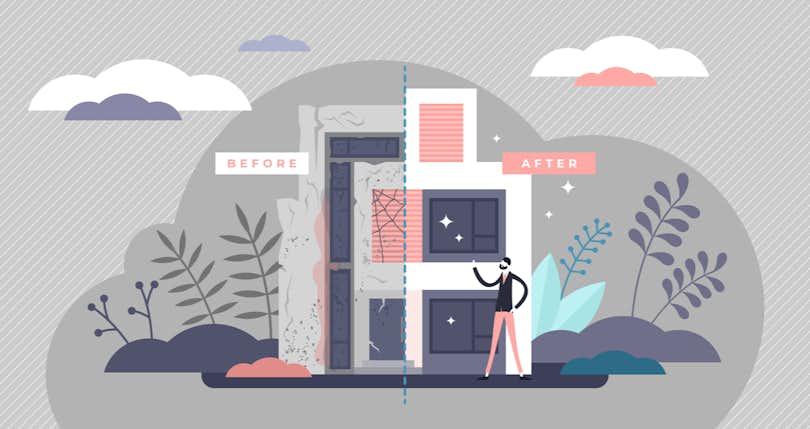Flipping a home means taking an ugly, distressed home and making upgrades to increase its value. Flippers find these homes at a deep discount, perform the work, and then sell for a profit. Here’s how to get started in flipping and key things to consider.

Whether you’re looking for a new career or just a side gig, flipping homes can be both profitable and rewarding if done right. Flipping a home is when you find a home in need of major repairs, updates, or renovations and bring it back to life. The key is finding the right property and flipping it fast.
Before you start canvassing the area for the perfect home to flip, you’ll also want to understand what it takes to flip a home and come up with a solid plan and a reasonable budget. If you’re a little leery of jumping straight into flipping, it can also be a good idea to buy a rental property first to get started in the industry. Again, just make sure you have a good budget in place before you buy to make sure you can actually turn a profit.
Get started
If you’re ready to make the leap into flipping homes, let’s get started!
When looking to break into the world of flipping, you can’t just wait for a great deal to find you. For every worthwhile and profitable deal you find, you’ll likely look at 100. Out of those 100, you may make an offer on 10 before finally getting one offer accepted.
The key is just to start looking. Find other investors and wholesalers through local real estate investor networking groups and let people know that you’re looking to buy. You can even try your hand at wholesaling, which is the process of getting great investment opportunities under contract and selling them to prospective investors.
What to buy
Beyond your personal skill set (hopefully you know how to use a hammer or run a drill!), try to define your goals and your perfect flip. It’s likely you won’t find exactly what you’re looking for, but it can help you target potential flips that you can realistically manage.
A good rule of thumb is to find a home with only cosmetic damage or the least expensive home in the most expensive neighborhood. Look for ugly homes with good bones. You can change nearly everything about a home, but you can’t change the neighborhood or the school district. Similarly, a bad roof can be patched, but a house with foundation issues can scare off potential buyers and increase your holding costs.
How to finance
If you’re like most new investors, you won’t be able to pay all cash for your first flip — or probably any of them. In fact, you may not have much of your own money to invest at all. You’ll likely need the help of a private lender offering a hard money loan. Unlike a traditional owner-occupied residential property, banks are not keen to loan money for flips. Flips can be risky ventures, and traditional lenders want to make sure they can get their money back out of the property should they need to foreclose on the house and sell it as-is.
Hard money lenders, however, will loan investors cash to purchase the home, as well as money to make needed repairs. The trade-off is a higher interest rate. While traditional 30-year mortgages charge an interest rate between 3% to 5% currently, a hard money loan can cost anywhere from 8% to 20% and you’ll have to pay it off much faster.
Essentially, you’re paying a premium for a lender to take a chance on you.
If you fail to pay back the full amount of the loan, the lender can foreclose on the home or you can offer them the deed in lieu of foreclosure. Read any terms closely prior to signing and consider your worst case scenario.
Make a plan
One of the most important parts of any successful flip is an accurate budget with some built-in padding. When purchasing a distressed property, most investors aim to make 10% to 20% in profit when all is said and done.
You can start to determine if this is feasible with a potential investment by finding the after-repair value (ARV) of the property. A general rule is that an investor should spend no more than 70% of a property’s ARV value after the cost of repairs. For example, if you determine you could sell a home for $200,000 after renovations and you expect $40,000 in costs, you should pay no more than $100,000.
($200,000 x 70%) - $40,000 = $100,000
Beyond this back-of-the-napkin calculation, run the numbers as accurately as you can. Try to get estimates for the work before signing a purchase agreement, as well as estimates for insurance, taxes, and any other costs you’ll incur while you’re working on the home — called holding costs.
The more months it takes you to perform the flip, the more you’ll pay in holdover costs. You may also consider timing — homes generally sell quicker and for more in the spring so you may aim for this as your target date to get the home market-ready.
Pro tip: We’ve developed a rental calculator to help investors analyze deals effectively.
Form your team and get to work
After you’ve found a property, secured a loan, and been handed the keys, the real work begins. Aside from a good budget to work from, start gathering a solid team before you even make an offer. For a distressed property — especially one with any structural or foundation damage — you’ll need a contractor experienced in this type of work to manage the project.
It may be tempting to serve as your own contractor, but unless you are one by trade or have extensive experience, it’s recommended to hire one for your first flip. They are knowledgeable about local regulations and permits and could save you thousands by doing things right the first time. Properties that are red tagged by a city can be especially tricky and you’ll need to have them inspected by the local building inspector after fixing things like the foundation, roof, framing, plumbing, or electrical.
Sell for profit
After you’ve finished your flip, it’s time to put in on the market, pay off your loan, and realize your gains. As with any home sale, spend some time working on the staging and presentation of the home, especially if your target buyer is someone purchasing the home as their primary residence. Don’t forget about landscaping — first impressions matter.
Work with a local, experienced real estate agent to help with preparing the home for sale, marketing, and negotiations. While it can be tempting to DIY, 36% of sellers who attempt to do a for-sale-by-owner (FSBO) end up enlisting the help of an agent. Plus, according to NAR, homes sold by agents have an average selling price of 23% more than FSBO sales.
How much will you make?
By using the 70% rule, paying close attention to your budget, and selling for the right price, you’ll profit nicely on your flip. Return-on-investment (ROI) varies greatly depending on the market, the neighborhood, your loan’s interest rate, and the cost of repairs in your area. Some of the top flip markets have a ROI of 100% or more, but as we mentioned, a more realistic number is in the range of 20%. Good luck!
